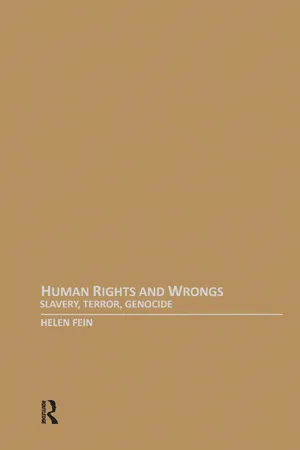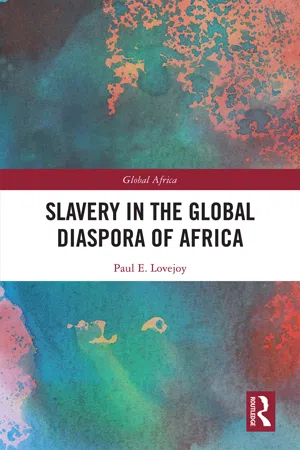Geography
Slavery
Slavery refers to the practice of owning and controlling people as property, often for forced labor. It has historically been a significant factor in shaping the geography of regions, as it influenced patterns of settlement, labor systems, and economic development. The legacy of slavery continues to impact geographical landscapes and social structures in various parts of the world.
Written by Perlego with AI-assistance
Related key terms
3 Key excerpts on "Slavery"
- eBook - ePub
Human Rights and Wrongs
Slavery, Terror, Genocide
- Helen Fein(Author)
- 2015(Publication Date)
- Routledge(Publisher)
2 Twentieth-Century Slavery within the State Slavery is the permanent, violent domination of natally alienated and generally dishonored persons…. We may summarize the two modes of representing the social death that was Slavery by saying that in the intrusive mode the slave was conceived of as someone who did not belong because he was an outsider, while in the extrusive mode the slave became an outsider because he did not or no longer belonged. —Orlando Patterson, Slavery and Social Death, 1982 It is widely believed that Slavery ended in the nineteenth century with the cessation of the transatlantic slave trade from Africa to North America, but it continues in other guises. This chapter focuses on Slavery within the state and the next chapter looks at global Slavery and trafficking for the sex trade among countries. One must ask: What constitutes Slavery fundamentally? Box 2.1 cites legal definitions of both Slavery and trafficking. The reader might note the broadening of the practices cited from 1956 to 2000 beyond the fact of ownership and the stress on motives of slaveholders and traffickers. Chattel Slavery—holding slaves as movable property that can be bought or sold—is one of many forms of Slavery, which include penal enslavement, state slave labor, and debt bondage. Slavery has an ancient history, as do other exploitative forms of labor. The addition in the 1956 Supplementary Convention of “the sale or involuntary transfer of women for marriage ‘without the right to refuse’” is consistent with the implication of autonomy in the sixth right in our list of life integrity rights (see table 1.1, ch. 1), “the right to procreate and cohabit with family.” The 1956 Convention focuses on slave traders, owners, and family members as violators. Violations by the latter include involuntary transfer of women in marriage for money, involuntary transfer of a wife to another person, and inheritance of the widow - eBook - ePub
- Paul E. Lovejoy(Author)
- 2019(Publication Date)
- Routledge(Publisher)
This study explores the conceptual problems of studying Slavery in Africa and the broader Atlantic world from a perspective that can be labeled an “Africanist” perception of the topic. I adopt a global approach, although my focus is specifically on Western Africa and the Americas, which inevitably avoids Western Europe, the Indian Ocean and indeed large parts of Africa and the Islamic world. Nonetheless, such an approach positions those who were enslaved at the center of the discourse on Slavery, not those who did the enslaving, traded in human beings, or profited from the labor of the enslaved population. Hence, my concern is with the parameters of the enforced migration of enslaved Africans, including the impact on civilian populations in Africa, constraints on migration and the importance of women and children in the movement of people who were enslaved. In the course of studying Slavery and societies in Africa over a period of several decades, I have come to appreciate the complexities of examining questions of identity in determining who were enslaved and why. The prevalence of Slavery in Africa and the transformations of social and political formations of societies and political structures during the era that corresponds with trans-Atlantic migration and indeed the traffic across the Sahara and the Indian Ocean have informed my research. The analysis that follows places Africa, specifically Western Africa, at the center of historical change, not on the frontier or periphery of Western Europe or the Americas. Thus, this analysis provides a global perspective that requires a reconsideration of historical reconstruction of the Atlantic world along lines that have finally challenged the distortions of Eurocentrism and national histories.This book examines the context of enslavement in Africa and the impact of identifiable groups of people on the development of diaspora in both Africa and the Americas. Such a focus concentrates on economy, culture and society and on the transformations that people experienced in the course of enforced migration. Conceptually, I try to discuss Slavery through the perceptions of individuals and therefore reevaluate approaches that are sociological and structural. I recount biographies as a way of revealing the life stories of individuals caught up in the slave trade and thereby personalize the study of Slavery, which often has been examined institutionally and abstractly at the expense of seeing that the historic crime against humanity that we refer to as Slavery actually involved people. The term “slave” as it is often used depersonalizes the individual and is avoided except as an adjective. Too often the perception of someone as a slave reveals the perspective of the master, not the person, and sometimes telescopes life stories, collapsing experiences from birth to death into one stage of a person’s life when he or she was held in Slavery, despite being born free. While many of those who were enslaved died in Slavery because of disease, brutality and willful neglect, many people actually were able to regain their freedom, however defined. Hence, to label all those who suffered Slavery as “slaves” not only represents the perspective of masters but also conflates the whole life of many people into an identity that was time and place specific. I hasten to add that avoidance of the term “slave” has emerged in my consciousness and hence now affects my analysis in ways that have evolved over the past several decades. - eBook - ePub
- Arthur H. Niehoff, Sidney W. Mintz(Authors)
- 2017(Publication Date)
- Routledge(Publisher)
But both of these definitions compel us to reflect upon the extent to which Slavery as a system for the unrestricted exaction of labor can operate without reference to the undeniable humanity of the enslaved. All Slavery may be Slavery, but not all slaveries are the same, economically or culturally. Through Slavery, human beings, their labor, their lives—that is, their production and reproduction—become commodities. In capitalistic societies in which a proletarian labor force sells its labor on the market, the price of labor is supposed to be determined in some large measure by the relationships of the labor supply to opportunities for employment. But Slavery represents an investment by the capitalist in the purchase not of labor alone, but of the laborer as well. It was the combination of Slavery—from the capitalist perspective, an archaic form of labor—with European overseas capitalism that gave to the New World situation its special, unusual, and ruthless character.Slavery is a complex term with many meanings (Davis 1966; Finley 1968; Genovese 1969). Fundamentally, however, Slavery rests upon coercion; the slave is, in certain important senses, the property of his master—as is, for instance, the master’s land and the master’s mule, though not the master’s wife or child. In one way or another, the slave is defined in such fashion that he is not a person—at least, not a person in all of the senses that a free man is a person in the same society. But of course the slave is a person—and both masters and slaves, in all of the Slavery systems of the New World, knew this, even if they were not always willing to admit it or able to say so.Slavery in the Americas
The economic advantageousness of Slavery in the New World was based on the relative scantiness of other forms of labor supply. The New World stretched from Tierra del Fuego to the Arctic, accessible to those who would plunder it; only the aboriginal peoples of the Hemisphere stood in the way. In areas of dense aboriginal concentrations, such as the Andes and highland Mexico, imported labor was not necessary or, at least, was not so commonly enslaved. But in all areas where the aboriginal population was sparse or soon destroyed, Slavery provided one sort of answer for the European colonizers. Thus it was that an institution already dead or dying in the metropolises could be spread, sometimes with remarkable speed and intensity, through the subtropical lowlands of the New World, particularly on the Atlantic periphery. In the Danish, Dutch, English, French, Portuguese, Spanish, and Swedish colonies, and in the United States, the slave trade and Slavery played an important role in the economic development of the “mother country.” Thompson (1932) has shown how this Western industrial Slavery, Slavery within capitalism, was basic to a pioneer institution, the plantation. The developmental problem was one of bringing into production large tracts of fertile land available for the asking, or little more than the asking, but in the absence of an adequate labor supply. The thrust toward such development grew ever stronger as plantation products were transformed from the luxuries of the rich—sugar, coffee, tobacco, rum—into the daily necessities of the urban proletarian masses in the metropolises.
Index pages curate the most relevant extracts from our library of academic textbooks. They’ve been created using an in-house natural language model (NLM), each adding context and meaning to key research topics.


